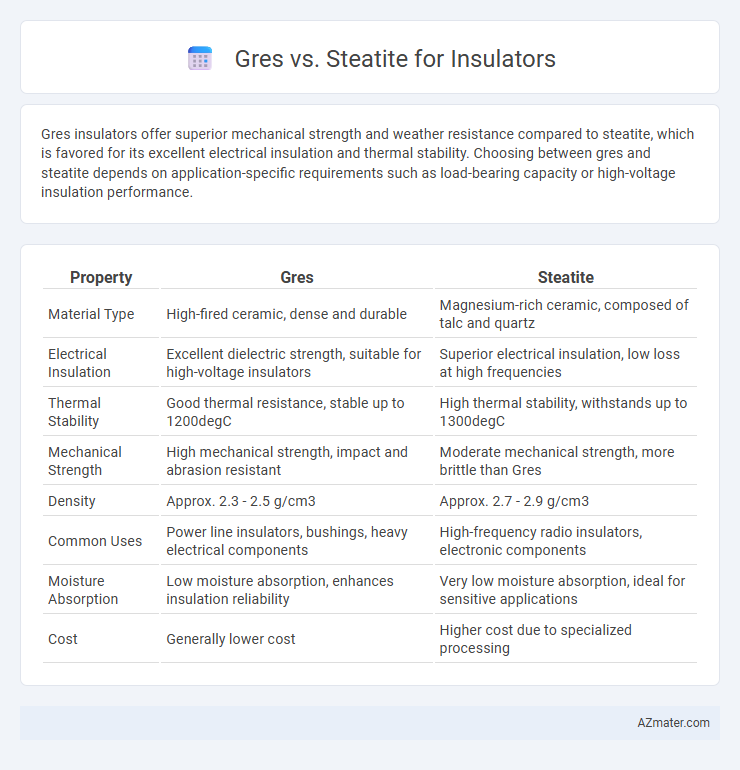Gres insulators offer superior mechanical strength and weather resistance compared to steatite, which is favored for its excellent electrical insulation and thermal stability. Choosing between gres and steatite depends on application-specific requirements such as load-bearing capacity or high-voltage insulation performance.
Table of Comparison
| Property | Gres | Steatite |
|---|---|---|
| Material Type | High-fired ceramic, dense and durable | Magnesium-rich ceramic, composed of talc and quartz |
| Electrical Insulation | Excellent dielectric strength, suitable for high-voltage insulators | Superior electrical insulation, low loss at high frequencies |
| Thermal Stability | Good thermal resistance, stable up to 1200degC | High thermal stability, withstands up to 1300degC |
| Mechanical Strength | High mechanical strength, impact and abrasion resistant | Moderate mechanical strength, more brittle than Gres |
| Density | Approx. 2.3 - 2.5 g/cm3 | Approx. 2.7 - 2.9 g/cm3 |
| Common Uses | Power line insulators, bushings, heavy electrical components | High-frequency radio insulators, electronic components |
| Moisture Absorption | Low moisture absorption, enhances insulation reliability | Very low moisture absorption, ideal for sensitive applications |
| Cost | Generally lower cost | Higher cost due to specialized processing |
Introduction to Gres and Steatite Insulators
Gres insulators, made from high-density porcelain, exhibit excellent mechanical strength and resistance to weathering, making them suitable for high-voltage power transmission. Steatite insulators, composed primarily of compressed and fired steatite powder, offer superior dielectric properties and thermal stability, ideal for applications requiring insulation under high electrical stress. Both materials provide critical insulation functions, but their distinct compositions influence performance characteristics in electrical and mechanical applications.
Chemical Composition Differences
Gres insulators are primarily composed of high-alumina clay mixed with other minerals, resulting in a dense, durable ceramic with excellent electrical insulation properties. Steatite insulators consist mainly of magnesium silicate (Mg3Si4O10(OH)2), offering superior thermal stability and resistance to chemical corrosion. The significant difference in chemical composition influences their respective thermal conductivity, mechanical strength, and suitability for different industrial applications.
Mechanical Strength Comparison
Gres insulators demonstrate superior mechanical strength due to their dense, vitrified ceramic composition, offering enhanced resistance to high compressive and tensile forces compared to steatite insulators. Steatite insulators, made from magnesium silicate ceramic, provide moderate mechanical strength but are more prone to micro-cracking under stress. The higher fracture toughness and hardness of gres make it the preferred choice for applications requiring robust durability in electrical insulation.
Electrical Insulation Properties
Gres and steatite are both ceramics used as electrical insulators, with steatite offering superior dielectric strength and lower electrical conductivity, making it highly effective for high-voltage applications. Gres provides good thermal stability but typically exhibits lower breakdown voltage compared to steatite, limiting its use in environments requiring stringent insulation performance. The moisture absorption rate of steatite is significantly lower, enhancing its insulation reliability under humid conditions.
Thermal Performance Analysis
Gres and steatite insulators exhibit distinct thermal performance characteristics, with steatite offering superior thermal conductivity and heat resistance due to its dense ceramic composition, making it ideal for high-temperature electrical applications. Gres, primarily a type of vitrified clay, demonstrates lower thermal conductivity but excels in thermal shock resistance, providing stability in environments with rapid temperature fluctuations. Thermal performance analysis shows steatite insulators maintain structural integrity and electrical insulation under prolonged high thermal stress, whereas gres is preferred for moderate thermal conditions requiring durability and cost efficiency.
Durability and Lifespan
Gres insulators exhibit superior durability due to their high mechanical strength and resistance to weathering, making them ideal for outdoor electrical applications. Steatite insulators, composed primarily of magnesium silicate, offer excellent thermal and electrical insulation but typically have a shorter lifespan compared to gres because they are more susceptible to physical wear and environmental stress. In terms of longevity, gres insulators generally outperform steatite, providing extended service life in demanding electrical systems.
Manufacturing Process Overview
Gres insulators are manufactured using high-fired porcelain clay subjected to temperatures above 1300degC, creating a dense, vitrified body with excellent mechanical strength and electrical insulation properties. Steatite insulators undergo a similar process but are made from purified talc-based ceramic powder, fired at lower temperatures around 1250degC to achieve high dielectric strength and thermal stability. Both manufacturing processes involve shaping, drying, and controlled kiln firing, but the raw material differences impact the final insulator performance in high-voltage and high-temperature applications.
Cost-Efficiency Assessment
Gres insulators typically offer a lower initial cost compared to steatite, making them more budget-friendly for large-scale projects. Steatite insulators provide higher durability and better mechanical strength, resulting in longer service life and reduced maintenance expenses over time. Evaluating cost-efficiency requires balancing immediate procurement costs of gres against the lifecycle savings and performance reliability of steatite insulators.
Common Applications in Industry
Gres insulators are commonly used in high-voltage electrical systems and power transmission due to their excellent mechanical strength and resistance to environmental stress. Steatite insulators find widespread application in electronics, telecommunications, and automotive industries because of their superior dielectric properties and thermal stability. Both materials are integral in manufacturing circuit breakers, transformers, and insulator components where reliability and electrical insulation are critical.
Choosing the Right Material for Your Needs
Gres insulators, made from high-quality feldspathic clay, offer superior mechanical strength and excellent thermal resistance, making them ideal for high-voltage and outdoor applications. Steatite insulators, composed of magnesium silicate, provide excellent electrical insulation properties combined with high toughness and resistance to moisture, suitable for compact and heavy-duty electrical components. Choose gres for durability in harsh environments where mechanical impact and weathering are concerns, while steatite is preferable when moisture resistance and precise electrical insulation in smaller, dense assemblies are critical.

Infographic: Gres vs Steatite for Insulator
 azmater.com
azmater.com